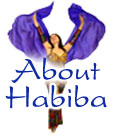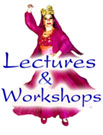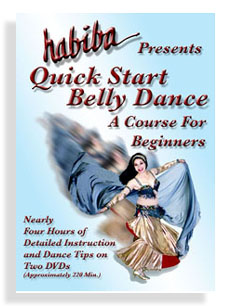- »Classes
- »Workshops/
Special Events - »Calendar
- »Gallery
- »Links
- »About Belly Dance
- »The Habiba Dance Ensemble website .








Habiba
The Studio
Habiba Dance Ensemble
.
.
.
.
.
.
.
.
DVDs
Habiba presents:
Quick Start Belly Dance
A 4-hour DVD course for beginners
On DVD, only $50.00 $35 plus $6 shipping and handling! NEW PRICE!....Buy it now!
Click here for more DVDs.
Read reviews of Quick Start Bellydance here.

 Belly
Dance is an effective, really fun way to exercise, tone the body, and
get an aerobic workout. You do not need to have any previous dance
training to enjoy this creative form of personal expression that is
done throughout the world by women of all ages.
Belly
Dance is an effective, really fun way to exercise, tone the body, and
get an aerobic workout. You do not need to have any previous dance
training to enjoy this creative form of personal expression that is
done throughout the world by women of all ages.
Habiba is a widely acclaimed
performer and teacher of Egyptian style Oriental Dance. She was
selected IAMED's 2001 Ethnic Dancer of the Year, and is an AAMED Belly Dance Hall of Fame inductee.
In Quick Start Belly Dance: a Course for Beginners,
Habiba presents the materials as a complete course, rather than as a
single class. The dance is taught in manageable mini-classes, complete
with assignments at the end of each segment. This allows the student to
master each step or movement group before moving on to the next
section, encouraging each individual to learn at a pace that is
comfortable for them. The individual class segments include: Warm-ups,
Undulations, Arms & Hands, Shoulder Shimmies, Hip Circles &
Figures Eights, Hip Articulations, Classic Egyptian Steps, and Entrance
& Travel Steps. After the basics have been mastered,
Habiba teaches a full seven-minute choreography, followed by a complete
performance of the choreography. A segment following the performance is
devoted to giving the students a number of tips and pointers, as well
as a bit of the history and lore associated with the dance and music of
the Middle East.
 Habiba wishes to thank Dr. Samy Farag & Sphinx Records for the use of the song Amarain in the production of these DVDs. Amarain was written by Melhem Barakat, was arranged and produced by Dr. Samy Farag, and is available on a CD entitled Rakasni Ya Habibi from PE-KO International Records. Email or call (818) 240-8888 for more information.
Habiba wishes to thank Dr. Samy Farag & Sphinx Records for the use of the song Amarain in the production of these DVDs. Amarain was written by Melhem Barakat, was arranged and produced by Dr. Samy Farag, and is available on a CD entitled Rakasni Ya Habibi from PE-KO International Records. Email or call (818) 240-8888 for more information.

Purchase Habiba's Quick Start Belly Dance today!
I really enjoyed this video set, now on DVD. It really does cover everything from posture to REAL history, practice segments for each series of movements taught, and a full choreography...Habiba is a great teacher and a scholar.
Aziyade
I have this DVD and it is great. Lessons broken down into units. It is a full course for beginners on Egyptian style. I practice to it daily. This is a good learning set for those that might not have a teacher close by that want a lesson course. It is very clear and concise format with drills and homework.
Akewa 2010
It's a great DVD set, packed with useful content. Especially for beginners, but 'advanced' beginners are sure to get much value out of it as well. Recommended.
Nikki Brown, Raqa Sharqi UK newsletter
(Note: the following are reviews of the videos; the DVDs contain exactly the same material.)
Review by Nikki Brown of Raqs-sharqi.com
(read full review here)
"...I thought this DVD course would be of great
benefit to a beginner taking classes for the first time, as it will
help them polish their basic technique, as well as challenge them with
the more difficult moves on the tapes. There is plenty of
material (3 hours 40 minutes!) to help the beginning student progress
their dance skills, and this course should be a useful reference tool
for them in their studies."

Review by Farasha
There are a myriad collection of
bellydance teaching DVDs on the market today, some better than
others. As a teacher, I’ve had a chance to
review a number of them, but for the most part, I’ve always approached
instructional DVDs with some trepidation and a lot of skepticism. Can
a student
truly and effectively learn this dance from watching a tape, as
opposed to
studying with a live teacher? Unless someone who really does
know how to
teach can convey DVDtaped instruction clearly and concisely, students
may get little out of the taped lesson.
That said, I was pleasantly surprised to discover a really
good, simply-produced, but highly effective instructional DVD by Habiba called,
Quick Start Belly Dance: A Course for Beginners. It’s a refreshing approach to Oriental dance technique, presented with clear, detailed explanation - so
essential for any beginner-level instruction. Habiba has a relaxed, personable
manner when she teaches (she’s one of those kind, giving teachers in person as well!),
and as the course progresses, my sense is that she is constantly trying to reach students in an individual way.
There are some important features about Habiba’s
approach
to beginning instruction that makes this tape worthwhile to watch and
learn from.
Rather than a single class, the dual-tape set is an actual course,
divided into a series of mini-classes, designed to give the student a
solid foundation in the dance at its end. Habiba explains that,
realistically, the lessons within this course could take up to 24-weeks
to master. She also includes a wide range of moves, some taking more
time than others to master. But there’s enough
basic material to get the dedicated student off and running.
The course is manageable and effective, comprised of 8
basic sections, and structured to build upon itself. At
the end of each section, there are actual assignments so students can
take the music and moves and practice
outside of the classroom as well. Habiba begins each section
with individual movements, which are then built into combinations at
the end of each
section. She also adds in several other elements during the lessons:
level changes,
changes in direction and tempo.
As the student learns the combinations from each
section,
s/he is also learning the choreography, which appears at the end of
Tape 2. In the
final class section, Habiba teaches a full 7-minute dance, and also
performs it.
Introducing the choreographic elements along the way makes it
easier to learn the entire dance by the end. It’s also a nice way of
introducing beginners -
who may never have experienced choreography - to the concept of how a
dance is put together.
The steps that were chosen by Habiba, and the
course
itself, were designed to expose students to a wide range of classic,
mostly Egyptian
movement. At the end of tape 2, Habiba also puts the dance into an
historical context, and discusses different types of rhythms and
costuming. But she saves these verbal notes for last, so students can
get down to moving from the very start.
Habiba begins- as all good lessons
should begin- with a Warmup,
and explains the proper posture- straight back, lifted chest- that are
new concepts for many beginners. After the initial stretches, Habiba
introduces the student to Undulations,
both upper body (ribcage) and lower body (the “camel”).
She breaks each one down individually to make these basic (but
sometimes
difficult) concepts easier to grasp. She then adds footwork as a
variation,
doing the undulation in place, traveling it from one side to the other,
traveling it in a circle, then forward and backward. Habiba uses this
technique successfully
with several of the basic steps, which helps to expand the movement
vocabulary. The practice assignment in this section alternates
the upper
and lower-body undulations in several combinations, so students can see
and grasp
the difference.
From there, Habiba moves onto Hands and Arms-
one of those
elements so often neglected by students and teachers alike, but so
essential to the overall beauty and power of this dance. I was glad to
see Habiba focus an
entire section on the many expressive hand and arm movements, including
a really nice sequence of four hand/arm positions. She later layers
this sequence with hip
and travel steps, to create new combinations. Habiba takes the time to
explain the importance of framing movement with the hands for
expression, and methods
of relaxing hands and positioning the arms. In movements such as “snake
arms,” she illustrates the different muscles in the arms that are used
to
create this motion.
In the Shoulder Shimmy section,
Habiba again
explains the importance of feeling the actual muscles in the back that
help drive the movement- a useful technique for helping students become
more familiar with the new and unfamiliar muscles used in this dance.
Habiba focuses a good deal of attention (and rightly so) on
Hip Movements, spending one section on the circular, softer movements of Hip
Circles and Figure-8’s, before moving onto the more staccato Hip Articulations. She
takes the basic circle and explains variations that make it more versatile- from
small and large circles, to half-circles around, adding footwork
and
traveling variations. I really like the little indicator graphical
arrows superimposed over the DVD to illustrate hip directions during
the
Figure-8 section, and which help visualize it for beginners. She has an
interesting way of teaching Vertical Figure-8’s (Snake Hips), showing
the travel variation first, then the stationery Figure-8, as a way of
getting students to first understand the weight shift involved.
She uses similar and detailed explanations for horizontal Figure-8’s,
and ends the section with practice assignments,
including an exercise that layers Figure-8’s and circles with the
arm/hand combinations learned earlier, illustrating how different
isolations link together in this
dance.
In the Hip Articulation
class, Habiba emphasizes the
importance of preparation in order to have good, clean hipwork,
reminding students to keep
the movement in the hips, without engaging the rest of the body. As a
teacher, I appreciate her in depth explanation of isolations - a
deceptively simple
concept that can cause problems for beginners- and she explains it in a
clear, precise manner. She breaks down some of the more
difficult hipwork, such
as downward Hips, in several steps, enabling students to see how the
movement
changes the position of the body.
Moving onto Hip Shimmies,
Habiba
looks at the problem of “shimmy paralysis” (didn’t all of us experience
that at one time!) and she has some useful
tips on how to avoid it. She introduces students to shimmies by
alternating a
shimmy with a non-shimmy move, so they have a chance to relax in
between, then gradually adds layering, such as a walking shimmy, and
focuses on increasing shimmy speed as students get more comfortable
with the movement.
Useful travel steps and combinations
occupy the last couple of sections, as Habiba covers Basic Egyptian Steps
(such as the familiar “kashlimar” travel) and she looks at several
typical Egyptian entrance steps, such as the
arabesque- with 3 different variations!- The Arabic hip walk, and the
chassé, a scooting travel move. The student who has taken
time to practice/master
the material beforehand, should have little trouble with these more
advanced movements.
As broader arm movements also begin to come into play, she offers
helpful hints,
such as don’t block your face with your arm!
Finally, Habiba moves onto the
actual Choreography,
which at this point in the tape is quite familiar, as she has been
introducing all the steps during
the entire course of classes. Habiba has a methodical approach to
teaching the choreography: She explains each step in a particular
section; she then counts out and dances the section; and she finally
dances the section to music. The choreography is delightful and, I
would add, a bit beyond absolute beginner level. But if students take
the time to study the material that precedes it, I believe it’s not too
difficult to master.
The last few of sections on
the tape,
although presented verbally, provide just as much crucial information
as the actual lessons to understanding bellydance. Habiba looks at the History
of the dance from a scholarly viewpoint,
helping to remove some of the stereotypical images that have so often
been associated with it. And she spends time exploring the unique
characteristics of
the dance: solo, improvised, interpretive, originally meant for a small
space, earth-oriented, etc. and the body mechanics which help define
it: lifted torso,
shifts of weight, arms which frame the movement. She talks about the
importance
of variety- changes in direction, level and timing- and the importance
of audience interaction and participation in the dance experience. She
looks finally at the importance of Rhythm, counting and how to place
accents, and the
difference between rhythmic and non-rhythmic music (such as a taqsim).
Last but not least, Habiba explores
the lure of costuming,
and its different styles, from bedlah to folkloric, with some
common-sense advice thrown in for good measure (Find the style of
costume that’s right for your body type; don’t
be a Christmas tree!)
Quickstart Belly Dance
is an
ambitious project- it’s almost four hours of material on two VHS tapes.
The end result is a well-thought out teaching tape, with logical
progression in movement and complexity, and a slow, sure pace, which
makes it easy for students to follow. Habiba has created a
clear, easy-to-understand and useful method for teaching bellydance. Her
instruction makes sense, she explores some common mistakes which
beginners face, and she constantly reinforces the concepts necessary to
execute the movements of this
dance. Quick Start Bellydance
offers a solid foundation in basic technique, that builds in complexity
as the student’s dance vocabulary and confidence grows. I think this is
a great teaching tool not only for students, but an inspiration
and guidance for other teachers. It’s one
instructional DVD I can truly recommend.
Template design by Six Shooter Media.
This website and all photographs within, are
©2010 Barbara Siegel, and may not
be used without her permission.
Website maintained by Fatima Bassmah








Habiba
The Studio
Habiba Dance Ensemble
.
.
.
.
.
.
.
.
DVDs
Quick Start Belly Dance
A 4-hour DVD course for beginners
On DVD, only
Click here for more DVDs.
Read reviews of Quick Start Bellydance here.
 Belly
Dance is an effective, really fun way to exercise, tone the body, and
get an aerobic workout. You do not need to have any previous dance
training to enjoy this creative form of personal expression that is
done throughout the world by women of all ages.
Belly
Dance is an effective, really fun way to exercise, tone the body, and
get an aerobic workout. You do not need to have any previous dance
training to enjoy this creative form of personal expression that is
done throughout the world by women of all ages.
Habiba is a widely acclaimed performer and teacher of Egyptian style Oriental Dance. She was selected IAMED's 2001 Ethnic Dancer of the Year, and is an AAMED Belly Dance Hall of Fame inductee.
In Quick Start Belly Dance: a Course for Beginners, Habiba presents the materials as a complete course, rather than as a single class. The dance is taught in manageable mini-classes, complete with assignments at the end of each segment. This allows the student to master each step or movement group before moving on to the next section, encouraging each individual to learn at a pace that is comfortable for them. The individual class segments include: Warm-ups, Undulations, Arms & Hands, Shoulder Shimmies, Hip Circles & Figures Eights, Hip Articulations, Classic Egyptian Steps, and Entrance & Travel Steps. After the basics have been mastered, Habiba teaches a full seven-minute choreography, followed by a complete performance of the choreography. A segment following the performance is devoted to giving the students a number of tips and pointers, as well as a bit of the history and lore associated with the dance and music of the Middle East.
 Habiba wishes to thank Dr. Samy Farag & Sphinx Records for the use of the song Amarain in the production of these DVDs. Amarain was written by Melhem Barakat, was arranged and produced by Dr. Samy Farag, and is available on a CD entitled Rakasni Ya Habibi from PE-KO International Records. Email or call (818) 240-8888 for more information.
Habiba wishes to thank Dr. Samy Farag & Sphinx Records for the use of the song Amarain in the production of these DVDs. Amarain was written by Melhem Barakat, was arranged and produced by Dr. Samy Farag, and is available on a CD entitled Rakasni Ya Habibi from PE-KO International Records. Email or call (818) 240-8888 for more information.
Purchase Habiba's Quick Start Belly Dance today!
I really enjoyed this video set, now on DVD. It really does cover everything from posture to REAL history, practice segments for each series of movements taught, and a full choreography...Habiba is a great teacher and a scholar.
Aziyade
I have this DVD and it is great. Lessons broken down into units. It is a full course for beginners on Egyptian style. I practice to it daily. This is a good learning set for those that might not have a teacher close by that want a lesson course. It is very clear and concise format with drills and homework.
Akewa 2010
It's a great DVD set, packed with useful content. Especially for beginners, but 'advanced' beginners are sure to get much value out of it as well. Recommended.
Nikki Brown, Raqa Sharqi UK newsletter
(Note: the following are reviews of the videos; the DVDs contain exactly the same material.)
Review by Nikki Brown of Raqs-sharqi.com
(read full review here)
"...I thought this DVD course would be of great
benefit to a beginner taking classes for the first time, as it will
help them polish their basic technique, as well as challenge them with
the more difficult moves on the tapes. There is plenty of
material (3 hours 40 minutes!) to help the beginning student progress
their dance skills, and this course should be a useful reference tool
for them in their studies."
Review by Farasha
That said, I was pleasantly surprised to discover a really good, simply-produced, but highly effective instructional DVD by Habiba called, Quick Start Belly Dance: A Course for Beginners. It’s a refreshing approach to Oriental dance technique, presented with clear, detailed explanation - so essential for any beginner-level instruction. Habiba has a relaxed, personable manner when she teaches (she’s one of those kind, giving teachers in person as well!), and as the course progresses, my sense is that she is constantly trying to reach students in an individual way.
There are some important features about Habiba’s approach to beginning instruction that makes this tape worthwhile to watch and learn from. Rather than a single class, the dual-tape set is an actual course, divided into a series of mini-classes, designed to give the student a solid foundation in the dance at its end. Habiba explains that, realistically, the lessons within this course could take up to 24-weeks to master. She also includes a wide range of moves, some taking more time than others to master. But there’s enough basic material to get the dedicated student off and running.
The course is manageable and effective, comprised of 8 basic sections, and structured to build upon itself. At the end of each section, there are actual assignments so students can take the music and moves and practice outside of the classroom as well. Habiba begins each section with individual movements, which are then built into combinations at the end of each section. She also adds in several other elements during the lessons: level changes, changes in direction and tempo.
As the student learns the combinations from each section, s/he is also learning the choreography, which appears at the end of Tape 2. In the final class section, Habiba teaches a full 7-minute dance, and also performs it. Introducing the choreographic elements along the way makes it easier to learn the entire dance by the end. It’s also a nice way of introducing beginners - who may never have experienced choreography - to the concept of how a dance is put together.
The steps that were chosen by Habiba, and the course itself, were designed to expose students to a wide range of classic, mostly Egyptian movement. At the end of tape 2, Habiba also puts the dance into an historical context, and discusses different types of rhythms and costuming. But she saves these verbal notes for last, so students can get down to moving from the very start.
From there, Habiba moves onto Hands and Arms- one of those elements so often neglected by students and teachers alike, but so essential to the overall beauty and power of this dance. I was glad to see Habiba focus an entire section on the many expressive hand and arm movements, including a really nice sequence of four hand/arm positions. She later layers this sequence with hip and travel steps, to create new combinations. Habiba takes the time to explain the importance of framing movement with the hands for expression, and methods of relaxing hands and positioning the arms. In movements such as “snake arms,” she illustrates the different muscles in the arms that are used to create this motion.
In the Shoulder Shimmy section, Habiba again explains the importance of feeling the actual muscles in the back that help drive the movement- a useful technique for helping students become more familiar with the new and unfamiliar muscles used in this dance.
Habiba focuses a good deal of attention (and rightly so) on Hip Movements, spending one section on the circular, softer movements of Hip Circles and Figure-8’s, before moving onto the more staccato Hip Articulations. She takes the basic circle and explains variations that make it more versatile- from
small and large circles, to half-circles around, adding footwork and traveling variations. I really like the little indicator graphical arrows superimposed over the DVD to illustrate hip directions during the Figure-8 section, and which help visualize it for beginners. She has an interesting way of teaching Vertical Figure-8’s (Snake Hips), showing the travel variation first, then the stationery Figure-8, as a way of getting students to first understand the weight shift involved. She uses similar and detailed explanations for horizontal Figure-8’s, and ends the section with practice assignments, including an exercise that layers Figure-8’s and circles with the arm/hand combinations learned earlier, illustrating how different isolations link together in this dance.
In the Hip Articulation class, Habiba emphasizes the importance of preparation in order to have good, clean hipwork, reminding students to keep the movement in the hips, without engaging the rest of the body. As a teacher, I appreciate her in depth explanation of isolations - a deceptively simple concept that can cause problems for beginners- and she explains it in a clear, precise manner. She breaks down some of the more difficult hipwork, such as downward Hips, in several steps, enabling students to see how the movement changes the position of the body.
Moving onto Hip Shimmies, Habiba looks at the problem of “shimmy paralysis” (didn’t all of us experience that at one time!) and she has some useful tips on how to avoid it. She introduces students to shimmies by alternating a shimmy with a non-shimmy move, so they have a chance to relax in between, then gradually adds layering, such as a walking shimmy, and focuses on increasing shimmy speed as students get more comfortable with the movement.
Useful travel steps and combinations occupy the last couple of sections, as Habiba covers Basic Egyptian Steps (such as the familiar “kashlimar” travel) and she looks at several typical Egyptian entrance steps, such as the arabesque- with 3 different variations!- The Arabic hip walk, and the chassé, a scooting travel move. The student who has taken time to practice/master the material beforehand, should have little trouble with these more advanced movements. As broader arm movements also begin to come into play, she offers helpful hints, such as don’t block your face with your arm!
Finally, Habiba moves onto the actual Choreography, which at this point in the tape is quite familiar, as she has been introducing all the steps during the entire course of classes. Habiba has a methodical approach to teaching the choreography: She explains each step in a particular section; she then counts out and dances the section; and she finally dances the section to music. The choreography is delightful and, I would add, a bit beyond absolute beginner level. But if students take the time to study the material that precedes it, I believe it’s not too difficult to master.
The last few of sections on the tape, although presented verbally, provide just as much crucial information as the actual lessons to understanding bellydance. Habiba looks at the History of the dance from a scholarly viewpoint, helping to remove some of the stereotypical images that have so often been associated with it. And she spends time exploring the unique characteristics of the dance: solo, improvised, interpretive, originally meant for a small space, earth-oriented, etc. and the body mechanics which help define it: lifted torso, shifts of weight, arms which frame the movement. She talks about the importance of variety- changes in direction, level and timing- and the importance of audience interaction and participation in the dance experience. She looks finally at the importance of Rhythm, counting and how to place accents, and the difference between rhythmic and non-rhythmic music (such as a taqsim).
Last but not least, Habiba explores the lure of costuming, and its different styles, from bedlah to folkloric, with some common-sense advice thrown in for good measure (Find the style of costume that’s right for your body type; don’t be a Christmas tree!)
Quickstart Belly Dance is an ambitious project- it’s almost four hours of material on two VHS tapes. The end result is a well-thought out teaching tape, with logical progression in movement and complexity, and a slow, sure pace, which makes it easy for students to follow. Habiba has created a clear, easy-to-understand and useful method for teaching bellydance. Her instruction makes sense, she explores some common mistakes which beginners face, and she constantly reinforces the concepts necessary to execute the movements of this dance. Quick Start Bellydance offers a solid foundation in basic technique, that builds in complexity as the student’s dance vocabulary and confidence grows. I think this is a great teaching tool not only for students, but an inspiration and guidance for other teachers. It’s one instructional DVD I can truly recommend.
Template design by Six Shooter Media.
This website and all photographs within, are
©2010 Barbara Siegel, and may not
be used without her permission.
Website maintained by Fatima Bassmah
